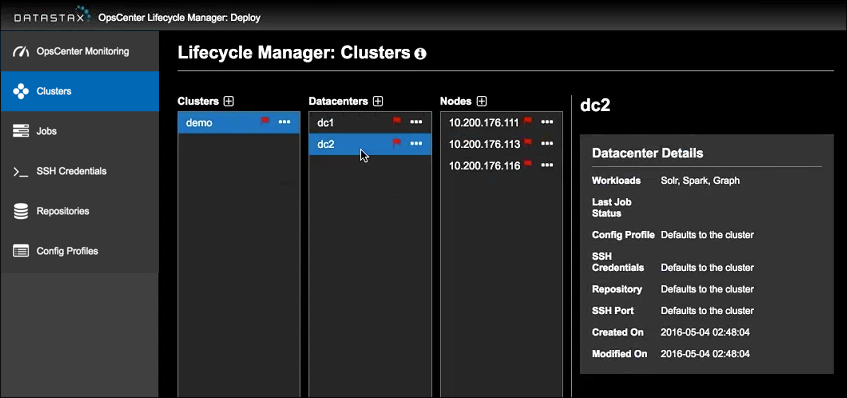Cluster topology overview
Explains the concepts of the logical cluster topology model that underpins OpsCenter.
lcm.db
The location of the Lifecycle Manager database lcm.db depends on the type of installation:- Package installations: /var/lib/opscenter/lcm.db
- Tarball installations: install_location/lcm.db
The Lifecycle Manager (LCM) topology model consists of cluster, datacenter, and node entities. The model facilitates installing and configuring DataStax Enterprise at the cluster, datacenter, and node levels. When installing and configuring DSE clusters, the model provides flexibility and powerful inheritance mechanisms.
LCM requires manually defining the cluster topology for new DataStax Enterprise clusters, or for clusters whose nodes do not use the same SSH credentials because the automatic cluster import process requires using a singular SSH credential. Automatically importing the cluster for existing DSE clusters imports the cluster topology and constructs the cluster model entities on your behalf in the Clusters workspace. The logical LCM model should reflect the actual physical topology of a cluster.
When deleting (that is, ceasing to manage) an entity from the topology model in LCM, you are simply removing management of the entity from LCM. Deleting a cluster, datacenter, or node in LCM does not affect the physical systems. Deleting entities from the LCM topology model causes LCM to stop managing and ignore them. The physical cluster, datacenters, nodes, and the corresponding entities in OpsCenter are not affected.
Lifecycle Manager: Clusters Workspace
The following graphic shows the fully expanded and populated Clusters, Datacenters, and Nodes panes prior to running an install and configure job:

| Status | Icon | Description |
|---|---|---|
| Not run | An install job has not been run on the topology entity. See running a job. | |
| Import (unmanaged cluster) | An existing cluster is not being managed by Lifecycle Manager. Click Start Managing and follow instructions to automatically import the cluster. | |
| Success | The job ran successfully on a topology entity (cluster, datacenter, or node). | |
| Failure | The job run on a topology entity (cluster, datacenter, or node) failed. Investigate the issue by drilling into the job details. Try running the job again. |
